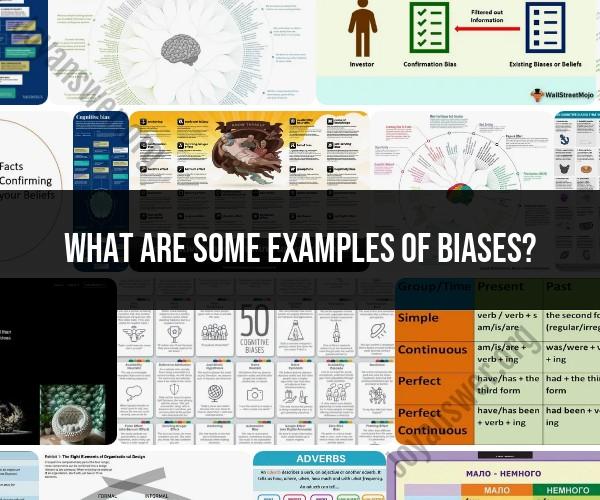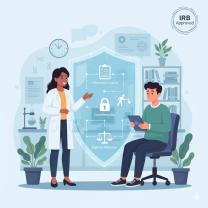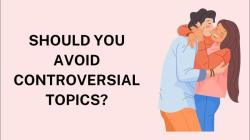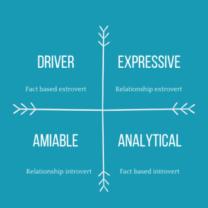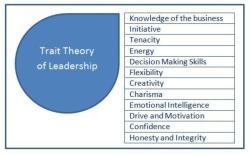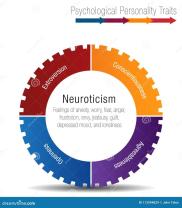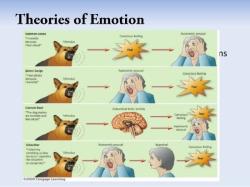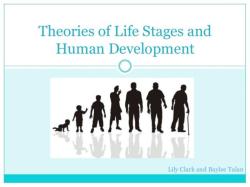What are some examples of biases?
Biases are systematic patterns of thinking or judgments that can lead to unfair, prejudiced, or irrational treatment of individuals or groups. There are many types of biases, and they can manifest in various contexts. Here are some common examples of biases:
Confirmation Bias: This is the tendency to search for, interpret, and remember information in a way that confirms one's preexisting beliefs or values while ignoring contradictory evidence.
Implicit Bias: Implicit biases are unconscious attitudes or stereotypes that affect our judgments and actions. These biases can be based on factors such as race, gender, age, or socioeconomic status.
Stereotyping: Stereotyping involves making generalized assumptions or beliefs about a particular group of people based on their perceived characteristics. For example, assuming that all members of a certain nationality are good at math.
Availability Heuristic: This bias involves giving more weight to information or examples that come readily to mind due to recent exposure or media coverage, even if they are not representative of the overall situation.
Anchoring Bias: Anchoring bias occurs when individuals rely too heavily on the first piece of information they receive (the "anchor") when making decisions. Subsequent information is often evaluated in relation to this anchor.
Halo Effect: The halo effect is a cognitive bias in which a person's overall impression of someone influences their judgments about that person's specific traits or abilities. For example, assuming that an attractive person is also intelligent and kind.
Recency Bias: This bias involves giving more weight to recent events or experiences when making judgments or decisions, while discounting older information.
In-Group Bias: In-group bias is the tendency to favor members of one's own group over those who belong to different groups. This bias can lead to discrimination against out-group members.
Authority Bias: People may be more likely to believe or follow the opinions or directives of authority figures, even when those opinions are not well-founded.
Overconfidence Bias: Overconfidence bias occurs when individuals tend to overestimate their own abilities, knowledge, or the accuracy of their beliefs and predictions.
Status Quo Bias: This bias involves a preference for maintaining the current state of affairs, even when change may be beneficial.
Gender Bias: Gender bias refers to biases or stereotypes based on a person's gender, often resulting in unequal treatment or opportunities.
Affinity Bias: Affinity bias occurs when people are more inclined to favor individuals who are similar to them in terms of background, interests, or values.
Racial Bias: Racial bias involves treating individuals differently or unfairly based on their race or ethnicity, often leading to racial discrimination.
Ageism: Ageism is a bias against individuals of a certain age group, typically older adults or younger people, resulting in unfair treatment or stereotypes.
It's important to recognize these biases, both in ourselves and in society, as they can have significant social, economic, and ethical implications. Awareness and efforts to mitigate biases are essential for promoting fairness, equality, and inclusivity in various aspects of life, including the workplace, education, and social interactions.
Shedding Light on Bias: Examples That Illuminate Our Cognitive Shortcuts
Cognitive biases are mental shortcuts that we use to make sense of the world around us. While they can be helpful in some situations, they can also lead us to make inaccurate judgments and decisions.
Here are a few examples of cognitive biases:
- Confirmation bias: We tend to seek out information that confirms our existing beliefs and ignore information that contradicts them. For example, if you believe that a certain politician is dishonest, you may be more likely to notice and remember news stories about their scandals, even if they are minor, and ignore news stories about their positive accomplishments.
- Availability bias: We tend to give more weight to information that is readily available to us. For example, if you are thinking about buying a new car, you may be more likely to consider the brands and models that are advertised on TV and in magazines, even if there are other, better options available.
- Anchoring bias: We tend to be influenced by the first piece of information we receive. For example, if you are negotiating a salary, the first number that is offered will set the anchor for the rest of the negotiation.
- Representativeness bias: We tend to judge things based on how similar they are to our prototypes of those things. For example, if you see someone who is dressed in a suit and tie, you may assume that they are a successful businessman, even if you know nothing else about them.
Cognitive biases can affect our thinking and decision-making in a variety of ways. For example, they can lead us to make inaccurate judgments about people, events, and products. They can also lead us to make poor financial decisions or to vote for the wrong candidates.
Cognitive Biases Unveiled: Real-Life Illustrations of Mental Prejudices
Cognitive biases are present in all aspects of our lives. Here are a few real-life illustrations of how cognitive biases can play out:
- A job interviewer may be more likely to hire a candidate who looks like them or who shares their background, even if the other candidate is more qualified.
- A doctor may be more likely to diagnose a patient with a common illness, even if the patient's symptoms suggest a more rare illness.
- A judge may be more likely to sentence a defendant to prison if they are poor or black, even if the defendant has committed the same crime as a defendant from a more privileged background.
- A voter may be more likely to vote for a candidate who is from their own political party or who shares their views, even if the other candidate is more qualified.
Cognitive biases can have a significant impact on our lives. By being aware of cognitive biases, we can better understand how they influence our thinking and decision-making. We can also take steps to mitigate the negative effects of cognitive biases.
Bias in Action: Recognizing and Analyzing Common Cognitive Pitfalls
Here are a few tips for recognizing and analyzing common cognitive pitfalls:
- Be aware of your own biases: Everyone has biases. The first step to mitigating their negative effects is to be aware of them. Try to identify the situations in which you are most likely to be biased.
- Consider multiple perspectives: When making a decision, try to consider all of the relevant information, even if it contradicts your existing beliefs.
- Seek out feedback: Ask others for their feedback on your decisions. This can help you to identify any biases that you may have overlooked.
By following these tips, you can reduce the impact of cognitive biases on your thinking and decision-making.
It is important to note that cognitive biases are not always negative. They can sometimes be helpful, such as when they allow us to make quick decisions in situations where time is limited. However, it is important to be aware of our biases so that we can avoid making inaccurate judgments and decisions.
